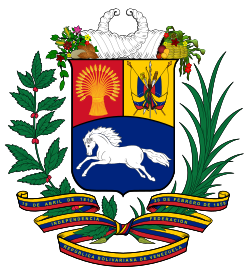| Coat of arms of Venezuela | |
|---|---|
 | |
| Versions | |
 1954−2006 | |
| Armiger | Bolivarian Republic of Venezuela |
| Adopted | March 12, 2006 |
| Motto | 19 DE ABRIL DE 1810 - INDEPENDENCIA (April 19, 1810 - Independence) |

The current coat of arms of Venezuela was primarily approved by the Congress on April 18, 1836, undergoing small modifications through history, reaching the present version.
The coat of arms was established in the Law of the National Flag, Shield and Anthem (Ley de Bandera, Escudo e Himno Nacionales), passed on February 17, 1954, by the military governor of Venezuela, Marcos Pérez Jiménez. The shield is divided in the colors of the national flag. In the dexter chief, on a red field, wheat represents the union of the 24 states of the Republic existing at the time and the wealth of the nation. In sinister chief, on a yellow field, weapons (a sword, a sabre and three lances) and two national flags are tied by a branch of laurel, as a symbol of triumph in war. In base, on a deep blue field, a wild white horse (representing Simón Bolívar's white horse Palomo) runs free, an emblem of independence and freedom.
Above the shield are two crossed cornucopias (horns of plenty), pouring out wealth. The shield is flanked by an olive branch and another of palm, both tied at the bottom of the coat with a large band that represents the national tricolour (yellow for the nation's wealth, blue for the ocean separating Venezuela from Spain, and red for the blood and courage of the people). The following captions appear in golden letters on the blue stripe:
| 19 de Abril de 1810 (April 19, 1810) | 20 de Febrero de 1859 (February 20, 1859) |
| Independencia (Independence) | Federación (Federation) |
| República Bolivariana de Venezuela (Bolivarian Republic of Venezuela) | |